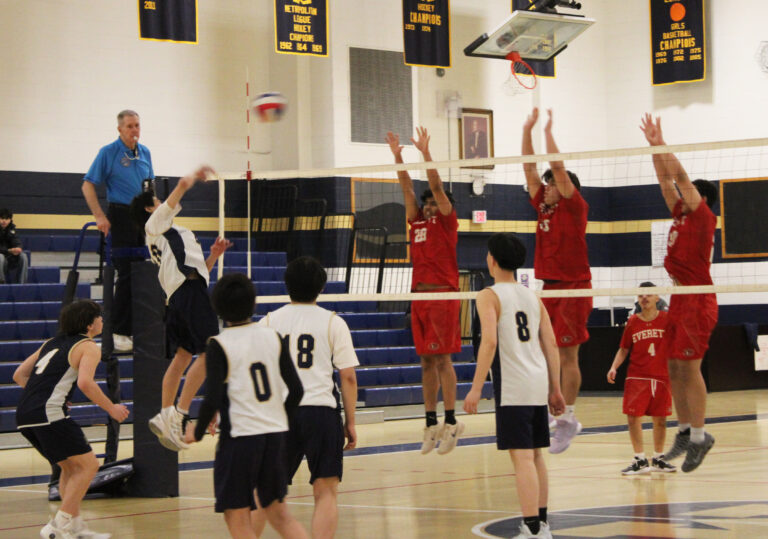
Delina Yohannes also contributed to this article.
Some students, after getting a bathroom pass and sitting in the bathroom waiting for class to end, get bored and start to express themselves on the walls. Graffiti on the bathroom walls has been a consistent issue at Malden High School, like most high schools, over the years as students see the empty canvas waiting to be filled with their every thought. As the year comes to an end, so do students’ patience and attention spans, which some feel leads to this issue of graffiti. However, Boyle House principal Caitlin Quinn seems to have found a solution: paper!
Quinn was not the only one to come up with the idea of hanging up pieces of paper; she was one of the few female administrative and hallway staff in a meeting about the bathrooms. “We were just trying to try something new, and I was noticing that some of the doodles were just that, doodles, or someone signing their name, or someone playing a tic tac toe game—things that I thought, ‘If this is going to keep happening and this…is not hurtful or having a major impact on our day to day and it could be solved by just putting up a piece of white paper instead of students doing that on the walls, why not try?’” explained Quinn.
The paper was not only added to help with the drawings but also the cost of repainting the walls after graffiti was drawn on them. Quinn clarified, “What happens is when we find stuff on the wall, we have to let our custodial staff know. The custodial staff then have to come in, close the bathrooms down because students can’t use it, and completely repaint the walls. This is time-consuming, costs money, and is not effective to continually have to do.” The paper, she continued, “was just a quick idea I thought would help prevent us from having to paint the wall once a week.”
This new option for students to express their creativity and thoughts was appreciated by the students and even made some gain respect for the staff. This gesture allowed students to expand on their art appropriately instead of being punished and closed off from their doodles. “I believe the poster boards are helpful, and I think they should keep it up until the graffiti calms down because I have been seeing a lot of people writing on the paper instead of the walls. I believe it’s helping,” stated sophomore Naomi Yohannes.
The paper being used was a surprise to everyone—even Quinn. “There were like ten students who happened to identify as female in my office at the time, and I was like, ‘What do you think?’ and I think every one of them laughed at me and were like ‘That’s not going to work, Miss! But we’ll help.’ They were even surprised that it did work a little bit. I don’t think they thought it made a difference but some students who like to doodle it did make a difference.”

However, the paper can only help so much as some students have rebelled against it and continued their graffiti elsewhere. Junior Mercedes Costa Aispuro said, “The paper didn’t work, [students] took the board off and started drawing underneath it or the other parts of the wall.” She believes that “people should be held accountable. It’s lowkey disturbing because you’re just trying to go to the bathroom and you see all these weird drawings and messages all over the walls.”
Sophomore Imane Agoumad echoed this sentiment, as she explained that there is “no message at all whatsoever; it’s honestly really disturbing reading it.” A lot of the graffiti seen in the bathroom is “very hateful, and if you’re sad and then you read someone’s hateful graffiti, it’s only going to make you more sad,” mentioned Agoumad.
Almost none of the graffiti seems to have a purpose and just stems from the boredom of the teenage mind or the hatred towards school and staff in and of itself. Students “just write swears and a lot of body parts and how they don’t like Mr. Mastrangelo, Mrs. Quinn, or any of the house principals, and it’s always in the big stall,” Costa Aispuro explained.
However, this issue is not limited to the girls’ bathrooms. Junior Yeleul Mekonnen remarked that in the boys’ bathrooms, there are only a few things on the walls, but students still “write stuff down like a bunch of profanity and body parts.” He continued, “Last week I went into the bathroom, and there was hate speech on the walls. Another time I was in the stall, and I saw a large inappropriate body part drawn on the wall.”

The graffiti is consistent within both gendered bathrooms, but the boys are not given the option of paper. “It wouldn’t even work, they’d still write it on the wall,” commented Mekonnen. This idea of the paper seemed to calm most of the doodles within the girls’ bathroom, but even so, he believes that “you can’t really stop it cause kids are going to act how they want. The problem is not even within the school, it is at home.”
As students try to use the restroom, they are only met with weird and disturbing images and phrases along the walls which can make the experience of using the bathroom uncomfortable.
However, not everyone writing on the walls has bad intentions. Hoping to spread kindness and interact with one another through the paper has improved the culture of the bathroom and the graffiti on the walls.

The paper has been positively received by most of the students using the bathroom, and Quinn hopes to only have the culture of the bathrooms improve more throughout the year. “If [the paper] is working, then I’m happy to keep restocking. I did say that if we liked the artwork that students are putting on it, that we would keep it hung up, so I’d like to start from the top on the bathroom walls and just hang what people have done so it doesn’t just get thrown out. It gets to stay if people are proud of what they drew.”
As the year progresses, the bathroom will continue to be a place where students go to get away from the stress of their classes. This escape for some is also a place for others to comfortably use for its purpose. The graffiti on the walls makes that experience uncomfortable and difficult, but as the paper continues to foster a safe environment and interaction between students, so does the culture of the bathroom in general. In these next months, hopefully, the art on the walls will come to an end as the year comes to an end and students grow in their next years at Malden High School.




